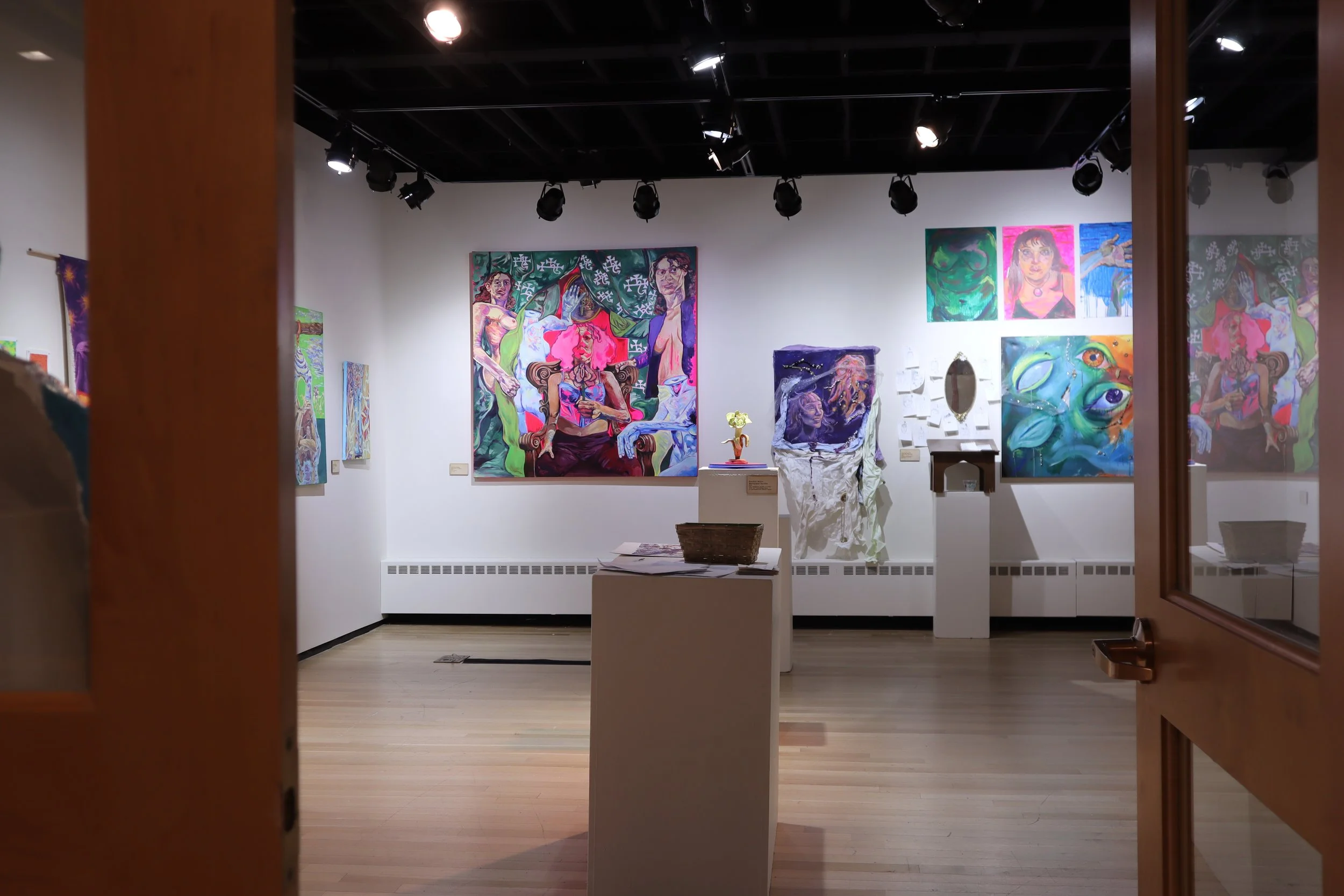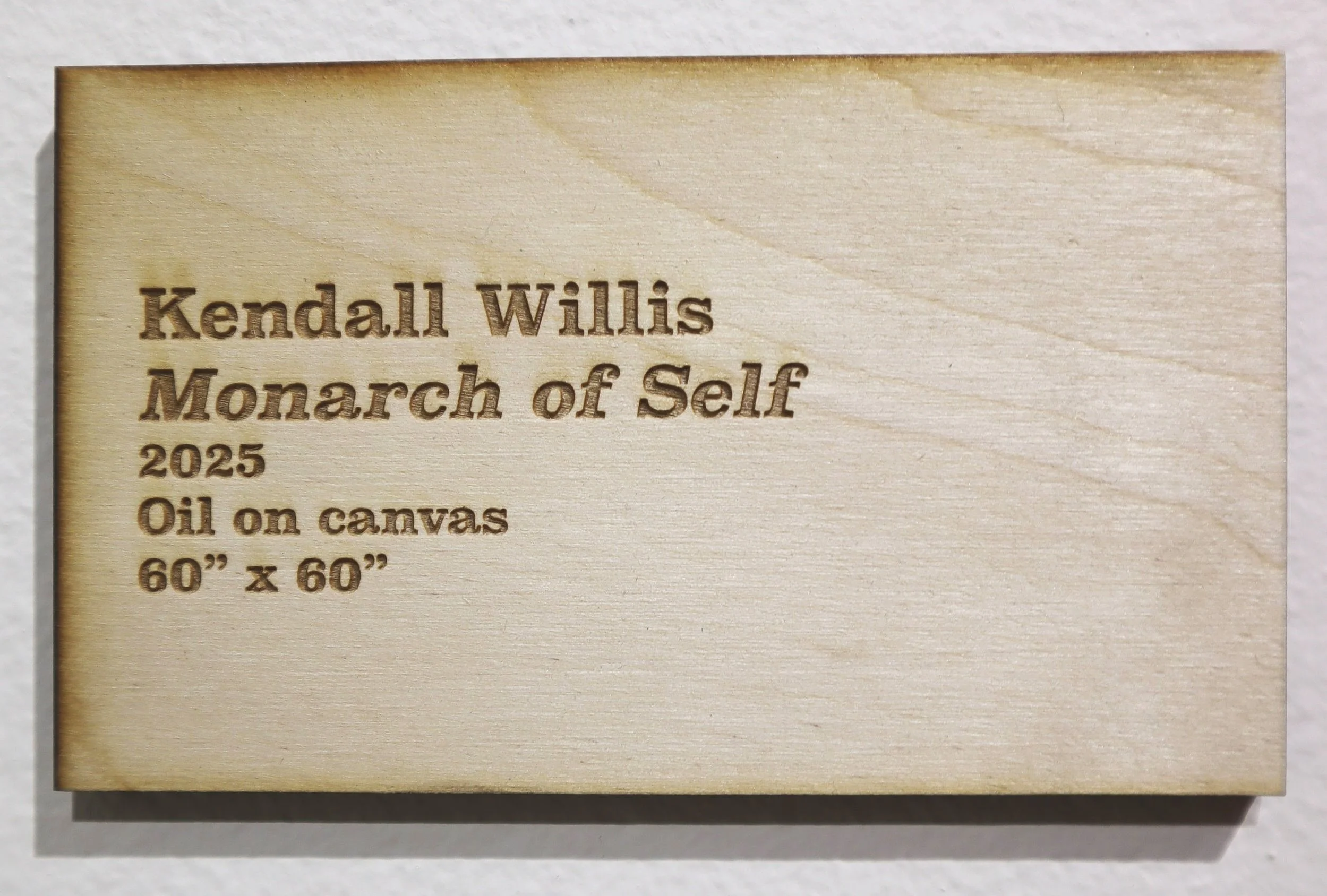April 10th - 14th, 2025
|
Mount Holyoke College
|
Blanchard Gallery
|
April 10th - 14th, 2025 | Mount Holyoke College | Blanchard Gallery |
Intertwined
Group Exhibition: Intertwined | April 10th - 14th, 2025 | Blanchard Gallery | Blanchard Hall | Mount Holyoke College
Blanchard Gallery presented the works of Audrey Leavitt, Glynnis Goff, Kendall Willis, Meadow Meredith, Miriam Xu, and Sherry Chen. Their collections orbit around the figure, tenderness, and communal intimacy.
Each piece begins with confrontation. It begins with my body—its curves, its weight, its presence— but it is not a singular self; rather, as a shifting form, a body of motion. The act of looking is intimate, but necessary. I pose, I shift, I question. It even holds a physical implantation in the making, oil paint holds the weight of the flesh, clay grips the imprint of hands; the press of form is made solid. My figure fractures, expands, dissolves into roots, into something ancient and new. But where do you see yourself in it? Can you find your reflection in the fold of the flesh, in the stretching of limbs, in the unraveling of identity? My body is personal, yet it is not mine alone.
What does it mean to reimagine the body? Something that is no longer fixed, but as something in bloom. What does it mean to shed, to split, to rebirth? This series is the product of the reclaimed transformation, looking at the body into a botanical, regrowing identity; the stages of the becoming. Challenging the rigid, gendered binaries construct one’s own identity, finding love within yourself. How can you love another without truly knowing yourself first? At the state, you are your own monarch. Here, identity is not a static truth but a garden in bloom, a shedding of old skin, a monarch with no need for a crown. The sole existence is to find the sacred of one’s own flesh, to see the body as one living, breathing archive of selfhood. Monarchs do not mourn the caterpillar—they honor what it was by becoming something new.
At the heart of these works is the conveying of the fragmented, the adorned, the dissolved, and the reborn. To “reconfigure the binary” is to question the foundations of the structures itself—the way the body is framed, how nature is perceived, and the histories we inherit. The Renaissance sought to define the ideal, crafting composition of order, proportion, and beauty as dictated by the cultural and religious norms. Yet, nature flourishes untamed, bodies twist with raw vitality, and transformation simmers beneath the surface. This series of works reclaims the lineage, not to mimic the past, but to challenge its constraints. The human form is the terrain, like a botanical garden, it cycles through stages. Do you stop to look at the flowers? Flowers, like bodies, hold folds; each skin has a different texture, color, and shape. It breathes; it lives. They bloom, decay, reseed, and return, never once the same.
It holds color. Color is breath, blood, and spirit—it stretches and contracts, pulses with longing, memory, and renewal. It is the heat of transformation, the body breaking open and rebuilding itself in a riot of hues. Color refuses containment, ever spilling, merging, and fracturing the ever-shifting state of identity. It embodies emotion, a visceral archive of love, resistance, and metamorphosis. In the end, metamorphosis is an act of survival. Color shifts, dark hues weighing heavily, absorbing grief, the desaturation of selfhood before rebirth. It blooms only to wilt; seeds fall only to sprout again. But color returns, tentative then bold. The body, too, is in perpetual flux. It resists the categorization, refusing to be still. We must push against the erasure, demanding presence. We must embrace the liminality, only to use it as a site of revision. Botanical forms merge with flesh, gender dissolves into fluid expression, and the self is reborn—not into one singular truth but into endless, unfolding possibilities.
The garden holds the arrival of the monarch. It is the terrain it drinks from, brushes against, lays beside. The garden is sacred for the space it holds. It holds scent. It offers a reminder: not all change is forward motion. Some power lies in stillness, in lush presence, in the act of simply being strange, blooming, and alive.
This piece marks the final threshold. This is a reconfiguration of spirit. A defiance of binaries. The monarch does not ask to be seen; it commands presence by existing in multiplicity. This is the moment the body realizes it is holy—not for it looks, but for how it survives, adapts, and claims joy. Only for the process to begin again.
This piece marks the second stage—an intimate, raw exhale of selfhood in flux. It is guttural, the petals do not fall in silence—they rupture, bleed, peel themselves away in thick, tender layers. There is no hiding in this bloom. It is menstruation. It is puberty. It is the ache of arrival before readiness. To bleed is to bloom. And through that truth, the monarch inches closer to its own sovereignty—one petal at a time.
A body suspended in transformation, wrapped in a thick silk of not-yet. This is the cocoon, the sacred pause. This form folds on itself, dissolves the known to make way for the unknown. The metamorphosis holds the body saying: I am not finished.





